Solved Examples and Worksheet for Creating Tables and Locating the Values on Coordinate Plane
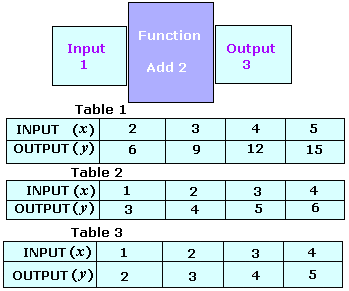
A. Table 1
B. Table 2
C. Table 3
D. None of the above
Step: 1
Let the input be x y
Step: 2
So, the function would be y x
Step: 3
So, Table 2 is the appropriate function table.
Correct Answer is : Table 2
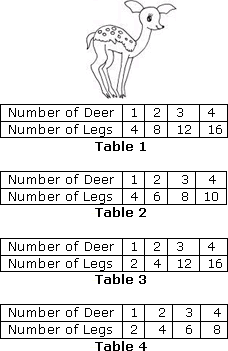
A. Table 1
B. Table 3
C. Table 2
D. Table 4
Step: 1
Each deer has 4 legs.
Step: 2
As the number of deer increases by 1, number of legs increases by 4.
Step: 3
So, Table 1 shows the correct relationship between the number of deer and the total number of legs they have.
Correct Answer is : Table 1
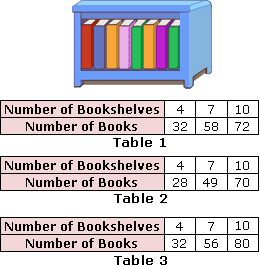
A. Table 3
B. Table 1
C. Table 2
Step: 1
Each bookshelf has 8 books.
Step: 2
As the number of bookshelves increases by 1, the number of books increases by 8.
Step: 3
Number of books in 4 bookshelves = 4 × Number of books in each bookshelf
= 4 × 8 = 32
[Substitute and multiply.]
Step: 4
Number of books in 7 bookshelves = 7 × Number of books in each bookshelf
= 7 × 8 = 56
[Substitute and multiply.]
Step: 5
Number of books in 10 bookshelves = 10 × Number of books in each bookshelf
= 10 × 8 = 80
[Substitute and multiply.]
Step: 6
The values obtained match the values in Table 3.
Step: 7
So, Table 3 shows the number of books in 4, 7, and 10 bookshelves.
Correct Answer is : Table 3
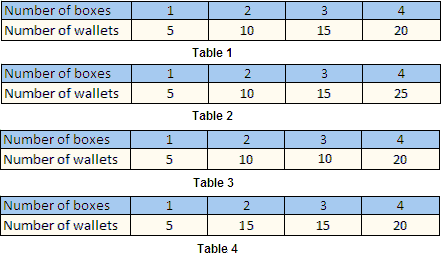
A. Table 3
B. Table 1
C. Table 4
D. Table 2
Step: 1
Given that a box has 5 wallets. By multiplying the number of boxes × 5, we get 10 wallets for 2 boxes.
Step: 2
Similarly, for 3 boxes we get 15 wallets and so on.
Step: 3
Therefore, Table 1 gives the correct answer.
Correct Answer is : Table 1
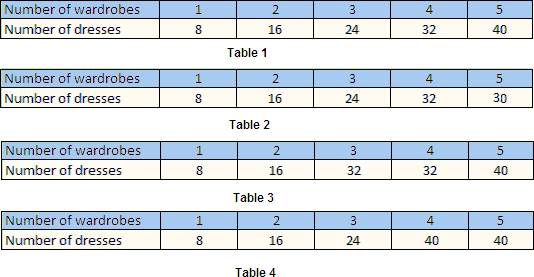
A. Table 2
B. Table 1
C. Table 4
D. Table 3
Step: 1
Given, a wardrobe holds 8 dresses. By multiplying the number of wardrobes × 8, we get 16 dresses for 2 wardrobes.
Step: 2
Similarly, for 3 wardrobes we get 24 dresses and so on.
Step: 3
Therefore, Table 1 gives the correct answer.
Correct Answer is : Table 1
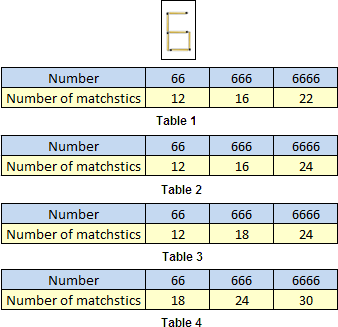
A. Table1
B. Table 3
C. Table 4
D. Table 2
Step: 1
Nathan made the number 6 with 6 matchsticks.
[Given.]
Step: 2
If he wants to make '66' he needs 2 sets of 6 matchsticks: 6 × 2 = 12.
Step: 3
To make '666' he needs 3 sets of 6 matchsticks: 6 × 3 = 18.
Step: 4
To make '6666' he needs 4 sets of 6 matchsticks: 6 × 4 = 24.
Step: 5
So, the number of matchsticks he needs to make '66', '666', and '6666' are matches with the values given in Table 3.
Step: 6
Therefore, Table 3 is the correct answer.
Correct Answer is : Table 3
| Tom | 2 | 4 | 6 | 8 |
| Bean | 4 | 8 | 12 | 16 |
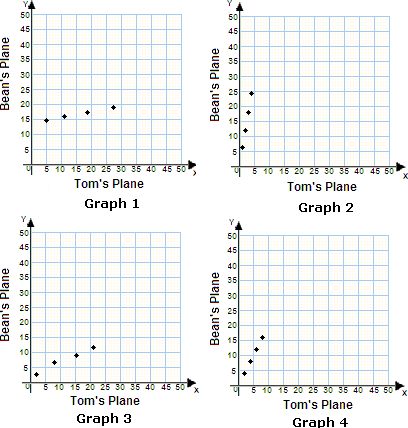
A. Graph 1
B. Graph 3
C. Graph 4
D. Graph 2
Step: 1
Tom's plane climbs 2 feet every second. That means, in 1st second 2 feet, in 2nd second 4 feet, in 3rd second 6 feet , in 4th second 8 feet etc.
Step: 2
Bean's plane climbs 4 feet every second. That means, in 1st second 4 feet, in 2nd second 8 feet, in 3rd second 12 feet , in 4th second 16 feet etc.
Step: 3
Therefore we can form ordered pairs from the corresponding terms of both the patterns as (2,4), (4,8), (6,12), and (8,16).
Step: 4
Now, Graph 4 matches with the given data.
Correct Answer is : Graph 4
| Number of Shelves | 1 | 2 | 3 | 4 |
| Number of Bottles | 8 | 16 | 24 | 32 |
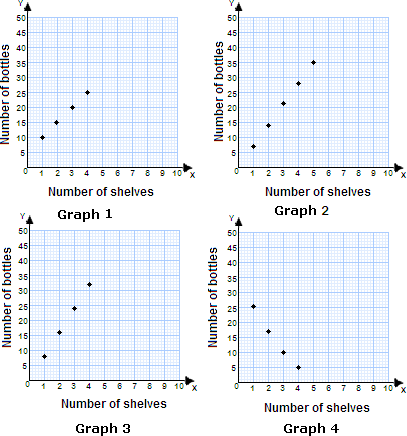
A. Graph 3
B. Graph 1
C. Graph 4
D. Graph 2
Step: 1
Given, a shelf holds 8 bottles. By multiplying the number of shelves multiplied by 8, we get 16 bottles for 2 shelves.
Step: 2
Similarly, for 3 shelves we get 24 bottles and so on.
Step: 3
Therefore we can form ordered pairs from the corresponding terms of both the patterns as (1, 8), (2, 16), (3, 24), and (4, 32).
[From the table]
Step: 4
Amongst the choices, Graph 3 matches with the given table.
Correct Answer is : Graph 3
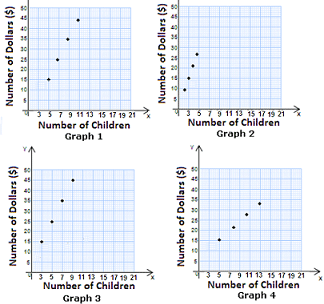
A. Graph 4
B. Graph 2
C. Graph 1
D. Graph 3
Step: 1
Mrs. Helen plans to spend $5 on gifts for each child at her son's birthday party.
Step: 2
The money she will spend for 3 children = 3 × $5 = $15.
Step: 3
The money she will spend for 5 children = 5 × $5 = $25.
Step: 4
The money she will spend for 7 children = 7 × $5 = $35.
Step: 5
The money she will spend for 9 children = 9 × $5 = $45.
Step: 6
So, the following Table shows the amount of money she spends for the party.


Step: 7
Therefore we can form ordered pairs from the corresponding terms of both the patterns as (3, 15), (5, 25), (7, 35), and (9, 45).
Step: 8
Now, graph the ordered pairs on the coordinate plane by taking number of children on X-axis and Number of dollars on Y-axis.
Step: 9
Amongst the choices, Graph 3 matches with the given data.
Correct Answer is : Graph 3
| Number of Boxes | 1 | 2 | 3 | 4 |
| Number of Pencils | 8 | 16 | 24 | 32 |
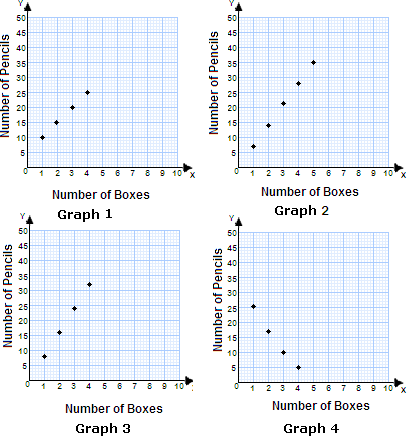
A. Graph 4
B. Graph 2
C. Graph 1
D. Graph 3
Step: 1
Given, a box has 8 pencils. By multiplying the number of boxes × 8, we get 16 pencils for 2 boxes.
Step: 2
Similarly, we get 24 pencils for 3 boxes and so on.
Step: 3
Therefore we can form ordered pairs from the corresponding terms of given table as (1, 8), (2, 16), (3,24), and (4, 32).
Step: 4
Now we can graph the ordered pairs on the coordinate plane by taking number of boxes on X-axis and total number of pencils on Y-axis.
Step: 5
Amongst the choices, graph 3 matches with the given data.
Correct Answer is : Graph 3
| Number of boys | 4 | 8 | 12 | 16 |
| Number of legs | 8 | 16 | 24 | 32 |
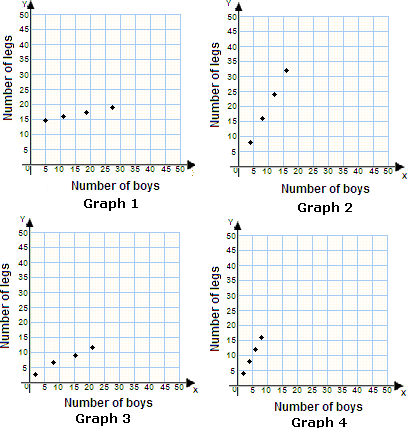
A. Graph 4
B. Graph 2
C. Graph 3
D. Graph 1
Step: 1
A boy has 2 legs. By multiplying the number of boys by 2, we get 8 legs for 4 boys.
Step: 2
Similarly, for 8 boys we get 16 legs.
Step: 3
Now, we can form ordered pairs from the corresponding terms of given table as (4, 8), (8, 16), (12,24), and (16,32) and graph them by taking number of boys on X-axis and total number of legs on Y-axis.
Step: 4
Amongst the choices, Graph 2 represents the given data.
Correct Answer is : Graph 2
- Simplify Numerical Expressions-Gr 5-Solved Examples
- Writing and Interpreting Numerical Expressions-Gr 5-Solved Examples
Related Worksheet
- Coordinate Plane